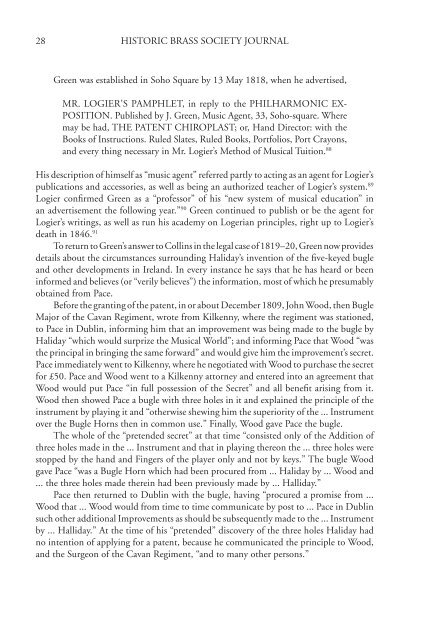New Light on the Early History of the Keyed Bugle Part I: The Astor ...
New Light on the Early History of the Keyed Bugle Part I: The Astor ...
New Light on the Early History of the Keyed Bugle Part I: The Astor ...
You also want an ePaper? Increase the reach of your titles
YUMPU automatically turns print PDFs into web optimized ePapers that Google loves.
28<br />
HISTORIC BRASS SOCIETY JOURNAL<br />
Green was established in Soho Square by 13 May 1818, when he advertised,<br />
MR. LOGIER’S PAMPHLET, in reply to <strong>the</strong> PHILHARMONIC EX-<br />
POSITION. Published by J. Green, Music Agent, 33, Soho-square. Where<br />
may be had, THE PATENT CHIROPLAST; or, Hand Director: with <strong>the</strong><br />
Books <strong>of</strong> Instructi<strong>on</strong>s. Ruled Slates, Ruled Books, Portfolios, Port Cray<strong>on</strong>s,<br />
and every thing necessary in Mr. Logier’s Method <strong>of</strong> Musical Tuiti<strong>on</strong>. 88<br />
His descripti<strong>on</strong> <strong>of</strong> himself as “music agent” referred partly to acting as an agent for Logier’s<br />
publicati<strong>on</strong>s and accessories, as well as being an authorized teacher <strong>of</strong> Logier’s system. 89<br />
Logier c<strong>on</strong>firmed Green as a “pr<strong>of</strong>essor” <strong>of</strong> his “new system <strong>of</strong> musical educati<strong>on</strong>” in<br />
an advertisement <strong>the</strong> following year.” 90 Green c<strong>on</strong>tinued to publish or be <strong>the</strong> agent for<br />
Logier’s writings, as well as run his academy <strong>on</strong> Logerian principles, right up to Logier’s<br />
death in 1846. 91<br />
To return to Green’s answer to Collins in <strong>the</strong> legal case <strong>of</strong> 1819–20, Green now provides<br />
details about <strong>the</strong> circumstances surrounding Haliday’s inventi<strong>on</strong> <strong>of</strong> <strong>the</strong> five-keyed bugle<br />
and o<strong>the</strong>r developments in Ireland. In every instance he says that he has heard or been<br />
informed and believes (or “verily believes”) <strong>the</strong> informati<strong>on</strong>, most <strong>of</strong> which he presumably<br />
obtained from Pace.<br />
Before <strong>the</strong> granting <strong>of</strong> <strong>the</strong> patent, in or about December 1809, John Wood, <strong>the</strong>n <strong>Bugle</strong><br />
Major <strong>of</strong> <strong>the</strong> Cavan Regiment, wrote from Kilkenny, where <strong>the</strong> regiment was stati<strong>on</strong>ed,<br />
to Pace in Dublin, informing him that an improvement was being made to <strong>the</strong> bugle by<br />
Haliday “which would surprize <strong>the</strong> Musical World”; and informing Pace that Wood “was<br />
<strong>the</strong> principal in bringing <strong>the</strong> same forward” and would give him <strong>the</strong> improvement’s secret.<br />
Pace immediately went to Kilkenny, where he negotiated with Wood to purchase <strong>the</strong> secret<br />
for £50. Pace and Wood went to a Kilkenny attorney and entered into an agreement that<br />
Wood would put Pace “in full possessi<strong>on</strong> <strong>of</strong> <strong>the</strong> Secret” and all benefit arising from it.<br />
Wood <strong>the</strong>n showed Pace a bugle with three holes in it and explained <strong>the</strong> principle <strong>of</strong> <strong>the</strong><br />
instrument by playing it and “o<strong>the</strong>rwise shewing him <strong>the</strong> superiority <strong>of</strong> <strong>the</strong> ... Instrument<br />
over <strong>the</strong> <strong>Bugle</strong> Horns <strong>the</strong>n in comm<strong>on</strong> use.” Finally, Wood gave Pace <strong>the</strong> bugle.<br />
<strong>The</strong> whole <strong>of</strong> <strong>the</strong> “pretended secret” at that time “c<strong>on</strong>sisted <strong>on</strong>ly <strong>of</strong> <strong>the</strong> Additi<strong>on</strong> <strong>of</strong><br />
three holes made in <strong>the</strong> ... Instrument and that in playing <strong>the</strong>re<strong>on</strong> <strong>the</strong> ... three holes were<br />
stopped by <strong>the</strong> hand and Fingers <strong>of</strong> <strong>the</strong> player <strong>on</strong>ly and not by keys.” <strong>The</strong> bugle Wood<br />
gave Pace “was a <strong>Bugle</strong> Horn which had been procured from ... Haliday by ... Wood and<br />
... <strong>the</strong> three holes made <strong>the</strong>rein had been previously made by ... Halliday.”<br />
Pace <strong>the</strong>n returned to Dublin with <strong>the</strong> bugle, having “procured a promise from ...<br />
Wood that ... Wood would from time to time communicate by post to ... Pace in Dublin<br />
such o<strong>the</strong>r additi<strong>on</strong>al Improvements as should be subsequently made to <strong>the</strong> ... Instrument<br />
by ... Halliday.” At <strong>the</strong> time <strong>of</strong> his “pretended” discovery <strong>of</strong> <strong>the</strong> three holes Haliday had<br />
no intenti<strong>on</strong> <strong>of</strong> applying for a patent, because he communicated <strong>the</strong> principle to Wood,<br />
and <strong>the</strong> Surge<strong>on</strong> <strong>of</strong> <strong>the</strong> Cavan Regiment, “and to many o<strong>the</strong>r pers<strong>on</strong>s.”

















